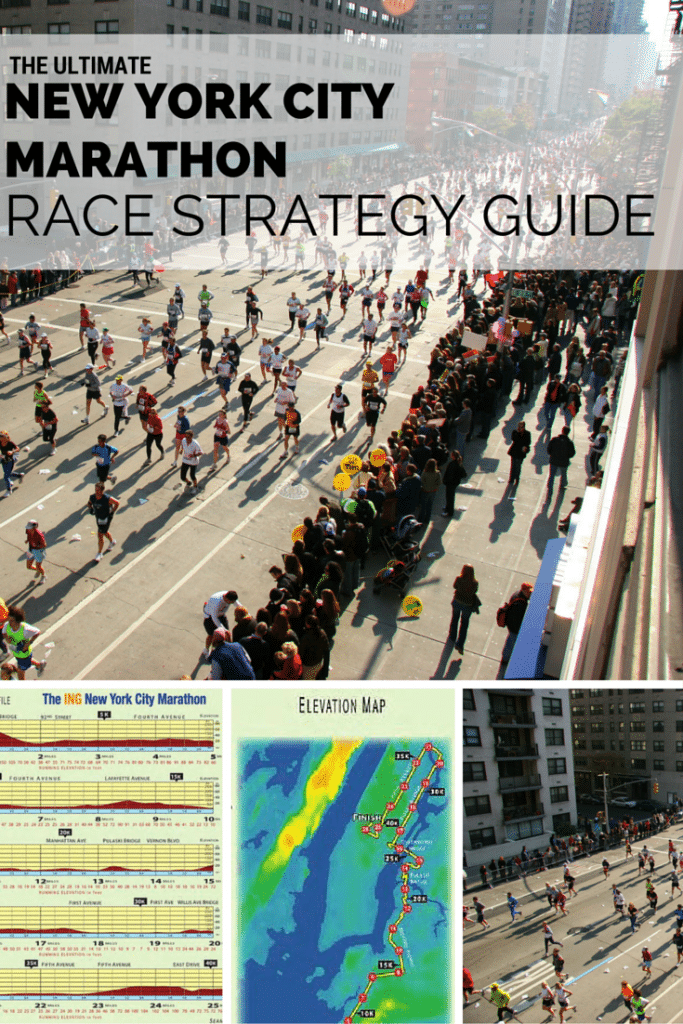 With just over 50,000 finishers each year, the New York City Marathon is the largest marathon in the world. It’s also one of the most difficult courses of the Major Marathons. With deceptively hilly bridges, a tough finish through Central Park, and screaming crowds that can make your adrenaline surge at the most inopportune times, the course can bring even the most elite runners to their knees.
With just over 50,000 finishers each year, the New York City Marathon is the largest marathon in the world. It’s also one of the most difficult courses of the Major Marathons. With deceptively hilly bridges, a tough finish through Central Park, and screaming crowds that can make your adrenaline surge at the most inopportune times, the course can bring even the most elite runners to their knees.
For these reasons, running the New York City Marathon requires a precise and meticulous race strategy that blends patience and cautious aggression that will allow you to keep the legs strong for the final hills and the glycogen in your system to prevent hitting the wall.
In this article, we’re going to break down each section of the New York City Marathon course and show you exactly how you should approach each mile for an optimal finishing time.
Pre Race Logistics
I’ve written extensively in previous posts about how to approach the last few days before a marathon race. In the interest of brevity, I will link to those articles so you can come back and read up on them later to help round out your race week training.
- You pre race nutrition plan for a marathon should start 5 days in advance of the race.
- If you’re interested in carbo loading for the marathon, here is our excellent piece on the three different ways to approach carbo loading.
- Here’s how to prepare logistically the week before a marathon.
- Since it’s a little difficult to determine what the weather will look like this year, here is an article about how to run a marathon in bad weather.
- Make sure you understand the difference between bonking, cramping, and fatigue.
New York City Marathon logistics
You’ll need to pick up your race number at the expo sometime between Friday morning and Saturday afternoon. Don’t forget to bring a printed copy of your registration and photo identification.
I am not a native New Yorker, but I do know getting to the start of the marathon can be a challenge. I don’t claim to know all the tricks, but I can point you to the official transportation plan of the marathon. Give yourself plenty of time and err on the side of too early than too late. You don’t want to waste energy stressing out.
If it’s cold or raining, bring extra clothes with you to the start you don’t mind throwing away. You’ll be standing for a while and you don’t want shivers to sap your energy.
New York City Course Profile and Race Strategy
As I mentioned previously, the NYC marathon course is deceptively hilly and the crowds (both fellow runners and the spectators) can distort your sense of pace. You will need to pay special attention to your pace and how you control your effort throughout the race.
I will outline each section specifically, but if you’re interested, here is a an interactive course profile and virtual tour of the course itself.
The first 2 miles – Stay patient
When the gun goes off, you’ll feel a surge of adrenaline and immediately be swarmed by thousands of runners. Your natural inclination will be to get out fast and establish your position.
The problem with this is is that the first mile is deceptively uphill. Unfortunately, for those runners that don’t read this guide, it means running even a little faster or at goal race pace is going to take more of a toll on your body than you realize or even feel. Therefore, it is absolutely critical you focus on your early pace and don’t let yourself start too fast.
Because getting around other runners will be difficult and the first .8 miles are uphill, the first mile should be about 45-60 seconds slow.
As you crest the bridge, the course starts going downhill. Avoid the temptation to surge around other runners and to let your pace get too fast. Surging past slower runners and getting uncomfortable in the tight crowds is an easy way to ruin your race. All the surges and stopping and starting requires a lot of energy. Energy = fuel, so the more energy and fuel you burn up during the first few miles, the less you’ll have over the last 10k. Take a deep breath and focus on relaxing.
Try to stay right on goal marathon EFFORT for the 2nd mile. Because of the downhill, marathon pace EFFORT will be about 10-15 seconds faster than goal pace.
Every few seconds faster than goal race pace in the first mile will cost you minutes in Central Park. You should plan on being about 30-45 seconds slower than goal finishing pace at 2 miles.
Miles 3-15 – Patience through Brooklyn
Your goal for miles 3 through 15 should be conserving energy and hitting the 59th street bridge feeling energized and strong.

You should plan on being about 5-10 seconds per mile slower than goal pace through this section. If you run conservatively, you’ll easily make this time up on the second half.
As soon as you enter Brooklyn coming off the Verazano bridge, the crowds are going to boisterous and the adrenaline is going to surge. Because you’re tapered, marathon pace will feel super easy.
The number one mistake runners make is getting caught up in the emotion here and running faster than goal pace. Block out the crowds and focus on your internal pacing and your own race.
The best strategy is to feel that the pace is too slow through Brooklyn and holding back until coming down the other side of the bridge just past half marathon.
Your overall cumulative pace should be about 60-90 seconds off cumulative goal pace at 15 miles.
It is important on the uphill section of the bridges, particularly the Pulaski and the 59th St. Bridge, to think about maintaining a consistent effort but not to attempt to maintain the same pace, let the pace slow a bit, not the effort, keep it the same.
Miles 16-20 – First Avenue
Coming off the Queensboro bridge and onto First Avenue is perhaps the most thrilling experience in marathoning. The crowds are huge and it feels like you’re running through a wall of sound. In addition, the entire run down First Ave is downhill.
You should use these miles to get back a small bit of time you lost on the bridges and the slow start. However, DON”T GO CRAZY. You don’t want to be more than 10-15 seconds per mile faster than goal pace on this section.
First Ave is not a license to speed. Cautiously pick up the pace and let the downhill do most of the work for you. Many marathoners run this section too fast and burn through their glycogen before the final 10k.
Remember, the marathon begins at 20 miles and you’re not there yet!
Overall, plan to make up about 40-60 seconds during these 3.5 miles on First Ave.
If you’ve followed the plan fairly closely so far, you should be right on pace or 30 seconds slow by mile 20. If you’re a little slow, that’s ok – it’s better than being a minute or two fast. Being slow will just give you more energy on the final hills.
Miles 20-23 – Time to go to work!
Miles 20-23 are where your training, patience, and strategy will start to pay off. You’ll also have to be mentally tough.
After the energy, excitement and fast pace of First Ave, you’ll feel a natural letdown as the course is slightly uphill and the crowds thin a bit. You’re also going to start feeling the miles accumulate in the legs and might have a few slow miles.
It’s important to stay mentally tough through this section. Don’t let a slow mile get you down. Keep refocusing on your internal effort. Recommit and keep the legs churning at goal pace as hard as you can.
Remember that this part of the course is ever-so-slightly uphill (especially the section between 23 and 23.5) and being 20-30 seconds slower than goal pace is ok if you’re not feeling good.
Miles 23 to the finish
You can try and make up a little time on the downhill on East Drive at 24.5 miles. This is a good section to try and get the legs moving and make up any pace you lost from miles 20-23.
The last 5k of a marathon are difficult no matter how fast you’re running or hilly the course is. Here are my race tips:
- Keep you mind and body relaxed. Look within yourself and focus on you. Think confident thoughts and repeat confident mantras to yourself; “I am fast, this feels good” or “I am strong, I’m running great”. Every time you feel tired or feel the pace slip, repeat to yourself that you need to refocus and concentrate and get back on pace.
- Often times, I’ll watch a video of fast marathon runners and when I start to hurt, I’ll imagine myself running like them. Good form – head straight, arms swinging forward and back slightly, powerful strides. Just having the mental imagery of good form helps me maintain my pace when the muscles become increasingly tired with each step.
- If the pace starts to slip, I’ll throw in a surge to get my legs fired up again. Sometimes all it takes is a small burst of speed to reinvigorate your legs and pace. Since you’ve done surges during your long run, this will be just like practice for you.
- Finally, I try to break the remaining distance into bite size and easily digestible pieces. After doing lots of hard training runs, I’ll break the race up into one of my best previous workout sessions. For example, if I had a great 2 x 3 mile session, I’ll remember how it felt and think to myself, “hey, I did this workout before, let’s get back on pace and do it again”. Likewise, sometimes a mile can seem like a long distance, so I’ll break it down into a time instead. Thinking I only have 3-4 minutes until I hit the halfway point of a mile makes it seem a lot easier. 4 minutes is nothing.
- Keep your head up and start to try and catch people in front of you. Pick one person and focus solely on reeling them in, nothing else. As you pass them, surge and put your eyes on the next person and repeat. Imagine tying a fishing line to their back and reeling them in. This will take your mind off the tiredness in the legs.
Good luck at your race this year. Run smart, execute your race strategy and let your fitness and preparation shine through to carry you to a new PR!





12 Responses
I’m doing a NYC race strategy for a client this week, and my calculations on the impact of the hills at NYC line right up with yours. Instead of reinventing the wheel, I’m pointing them here for the “color commentary” – thanks!
Of course this assumes the race happens, which is likely – though pre-race logistics may be a bit of a nightmare.
Glad we’re on the same page, Greg! It’s always fun to watch the elites run and see them execute – that’s where a lot of this guide comes from.
Jeff, I want to follow your plan for this year 2014. I’m hoping for a sub-4 finish. Do the 20-30sec advices work regardless of goal pace?
AND, when you say:
“Remember that this part of the course is ever-so-slightly uphill (especially the section between 23 and 23.5) and being 20-30 seconds slower than goal pace is ok if you’re not feeling good.”
Do you mean that in my case it’s ok if the AVERAGE PACE to this point is 20-30s slower?
That means that for each mile from 23 to 26, I must be 10s faster than my MP?
I work in Km’s – how does this translate?
I did the NYC 18mile Tune up VERY COMFORTABLY yesterday in 3h13. Someone along the course said that this (3X6mile loops around CP) was way more climbing than the whole NYC marathon????
This will be my first marathon; I’m nervous!
Dipak
Yes, the surges work regardless of pace. The surge is just faster or slower based on how fast you’re running.
Yes, this would be average pace – more of it will come from 23.23.5. You make up most of the time before this on the downhill section on First Ave. Kiloneters, mile 23 is 37km.
Best of luck, sounds like you’re ready to roll!
Hey there Coach, this was a great read!!! will be running the 2013 edition after 2012 Sandy and 2011 injured.
My goal is a sub 3, trying to break my PB of 3:09 from May 2013.
Wanted to ask, how good are the pace keepers in the race? Can I trust them to be in line with your advice, or will they just keep a steady 4:16 per K throughout the race?
I haven’t used the Pace Groups in NYC, but this will help: https://runnersconnect.net/coach-corner/marathon-trainingn-why-following-pace-group-could-ruin-your-chances-of-pr/
This was an excellent read and look forward to running New York. I plan on breaking 2:40 and I know race strategy plays a vital role. How would you compare this course to Boston?
Thanks for the strategies and honest insight into what is a tough marathon. But a marathon worth doing! Planning on a solid- conservative pace just under 4…
Good luck to my fellow 2014 NYC runners.
Hi,
I’ve read careffuly your article about pace strategy. My best marathon is around 3:43 in Paris. I would like to be around the same in NY this year but when i look at the profile it starts to frighten me a little and thinking that less than 4:00 could be ok..
Thanks Jeff. Great article. This sounds like a great strategy to run NYCM and aligns with what I was planning to do. I’m doing NYCM in 6 days and will do the best to stick to this plan.
I just made the calcs and is almost 100% accurate, thanks a lot
Another good article.